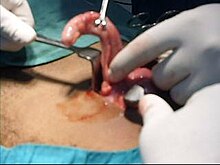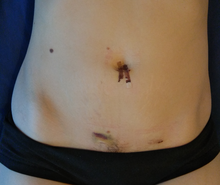Appendectomy
The appendectomy is the surgical removal of the vermiform appendix , the appendix to the cecum . The colloquial term " appendix removal " is misleading, as the appendix itself only has to be removed in rare cases.
indication
The clinical suspicion of acute appendicitis is the most common and urgent indication for appendectomy. Recurrent , atypical right-sided lower abdominal complaints, after excluding another disease ( salpingitis , cystitis, etc.), also lead to an appendectomy indication. Tumorous changes (appendix carcinoid ) are often symptom-free and are noticeable during operations for other reasons. They then also represent an indication for appendectomy. The prophylactic appendectomy z. B. Before long stays in medically underserved areas is controversial, but still occasionally carried out.
Operating principle
The blood supply to the vermiform appendix via the mesoappendix (previously mesenteriolum ) is interrupted and severed by ligature or electrocoagulation . The Appendix is then at the base, i.e. at the transition from the appendix to the caecum (cecum) inhibited and stopped. In the conventional procedure, the ligament is tied using absorbable suture, in the laparoscopic procedure this is used as a Röder loop . Alternatively, a forklift can also be used here . The stump can be everted into the caecum through a purse- string suture or left after disinfection. In the case of highly inflammatory findings, a target drain is inserted.
Vermiform appendix prior to laparoscopic removal
Access routes
Access is via laparotomy or laparoscopy . One speaks therefore of conventional and laparoscopic appendectomy.
Conventional approach
Typical:
- Alternating incision according to McBurney (1894): Short oblique incision on the right lower abdomen, opening of the fascia , the fibers of the abdominal muscles ( M. rectus abdominis , M. obliquus externus abdominis , M. obliquus internus abdominis ) are pushed apart in their course, exposure and opening of the peritoneum . Also popularly known as the "bikini cut".
- Pararectal incision: as above, however, the lateral boundary of the rectus abdominis muscle is included.
- Transrectal section: Longitudinal section of the right lower abdomen, longitudinal division of the rectus abdominis muscle. This incision is preferred for obese patients or extremely acute / unclear findings, as it can be extended as required.
Atypical:
- Middle incision of the lower abdomen (medial laparotomy): If the diagnosis is unclear or there is a high probability of severe adhesions .
Laparoscopic approach
The access for the optics is usually created just below the navel with an approx. 10 mm long skin incision. Two working accesses (5 mm and 10 mm) are made on the lower abdomen at the upper limit of the pubic hair.
Risks and Complications

Typical complications and therefore risks of appendectomy are: Insufficiency of the appendix stump (i.e. failure to hold the suture) with subsequent abscess or even purulent peritonitis ( peritonitis ); Wound infection (especially if the appendix is perforated by intraoperative spreading of pathogens into the abdominal wall), adhesions , occasionally with the consequence of an intestinal obstruction ( ileus ), (re) bleeding, injury to the intestine, ureter or other neighboring organs , incisional hernia .
Comparison of conventional / laparoscopic procedures
Advantages of the laparoscopic procedure
- Cosmetically moderately superior
- Possibility of diagnosing the entire abdomen, especially validation of the differential diagnosis of salpingitis , ovarian cyst
- Lower rate of wound healing disorders
- Faster convalescence
- Incisional hernias (incisional hernias) less often
Advantages of the conventional process
- Less equipment required
- Easier possibility of extending the intervention
The costs of the two procedures differ only marginally when the Röder loop is used (laparoscopic); the laparoscopic instruments are available in every clinic in German-speaking countries.
history
The first appendectomy was performed by Claudius Amyand , the surgeon of George II , rather by accident on an eleven-year-old boy. It took place in 1735 at St. George's Hospital in London . Robert Lawson Tait followed in 1880 . In Berlin, Max Schüller (1843–1907) carried out Germany's first successful appendectomy in 1889. The early operation of appendicitis only prevailed in Germany after the President of the Reich Friedrich Ebert died in 1925 of an appendix perforation (rupture of the appendix). The Russian surgeon Leonid Rogozov appendectomized himself in 1961.
The laparoscopic appendectomy was performed worldwide for the first time on September 13, 1980 at the Christian-Albrechts-Universität zu Kiel by the gynecologist Kurt Semm . At that time, therapeutic operative laparoscopy was still highly controversial. In 1981, after Semm's lecture on laparoscopic appendectomy , the President of the German Society for Surgery demanded in a letter to the board of the German Society for Gynecology and Obstetrics that Kurt Semm's license be withdrawn. A scientific publication on laparoscopic appendectomy in the American Journal of Obstetrics and Gynecology was rejected on the grounds that the technique was unethical.
In Germany, the number of operations fell from 156,654 (in 2000) to 99,024 (in 2017).
research
A 2014 study at Turku University Medical Center showed that antibiotic treatment can in some cases eliminate the need for surgical appendectomy. However, it is unclear whether this approach ultimately benefits patients.
literature
- Volker Schumpelick: Surgery atlas . Thieme, Stuttgart 2006, ISBN 3-13-140632-1 ( limited preview in the Google book search).
- Johannes W. Rohen, Jürgen Durst, Hans Arnholdt: Abdominal surgery: Operating theory with topographical anatomy: standards of visceral surgery . Schattauer, Stuttgart a. a. 1998, ISBN 3-7945-1590-0 ( limited preview in Google Book Search).
- Karl-Heinz Reutter, Reinhard Baumann: Surgery essentials: Intensive course for further training . Thieme, Stuttgart / New York 2004, ISBN 3-13-126345-8 ( limited preview in the Google book search).
- Liselotte Mettler : Endoscopic Abdominal Surgery in Gynecology . Schattauer, Stuttgart a. a. 2002, ISBN 3-7945-1965-5 ( full text in the Google book search).
- Karl-Walter Jauch, Wolf Mutschler, Matthias Wichmann: Basic surgery training: In 99 steps through the common trunk . Springer, Heidelberg a. a. 2007, ISBN 978-3-540-34004-1 ( limited preview in Google Book Search).
Web links
- Appendectomy (appendectomy) - information from the Federal Association for Outpatient Surgery e. V.
Individual evidence
- ↑ Ernst Kern : Seeing - Thinking - Acting of a surgeon in the 20th century. ecomed, Landsberg am Lech 2000, ISBN 3-609-20149-5 , p. 202.
- ^ Entry by Claudius Amyand in The Twickenham Museum
- ^ Heinz-Peter Schmiedebach, Rolf Winau, Rudolf Häring (eds.): First operations in Berlin surgeons 1817–1931. Walter de Gruyter, Berlin / New Yorl 1990, ISBN 3-11-011951-X . P. 10.
- ↑ Ernst Kern : Seeing - Thinking - Acting of a surgeon in the 20th century. ecomed, Landsberg am Lech 2000, ISBN 3-609-20149-5 , p. 202.
- ↑ How the Russian Leonid Rogozov removed his appendix in the Antarctic. In: stern. April 1, 2018, accessed February 5, 2020 .
- ↑ Kurt Semm : Endoscopic appendectomy. Endoscopy 15: 59-64 (1983), PMID 6221925
- ^ Technical surgical steps of endoscopic appendectomy. Langenbecks Arch Chir 376 (1991), 121-6, PMID 1829131
- ↑ K. Bhattacharya: Kurt Semm: A laparoscopic crusader . In: Journal of Minimal Access Surgery . No. 3 , 2007, p. 35-36 , doi : 10.4103 / 0972-9941.30686 .
- ↑ Barbara Supp: Everything used to be worse: No 187: Appendectomy . In: Der Spiegel . No. 32 , 2019, p. 46 ( online - August 3, 2019 ).
- ↑ Study: Antibiotics often make appendix surgery superfluous . On: spiegel.de from June 17, 2015.
- ↑ Paulina Salminen, Hannu Paajanen, Tero Rautio u. a .: Antibiotic Therapy vs Appendectomy for Treatment of Uncomplicated Acute Appendicitis: The APPAC Randomized Clinical Trial. In: The Journal of the American Medical Association . (JAMA) 2015, Volume 313, No. 23, pp. 2340-2348, doi: 10.1001 / jama.2015.6154 .





